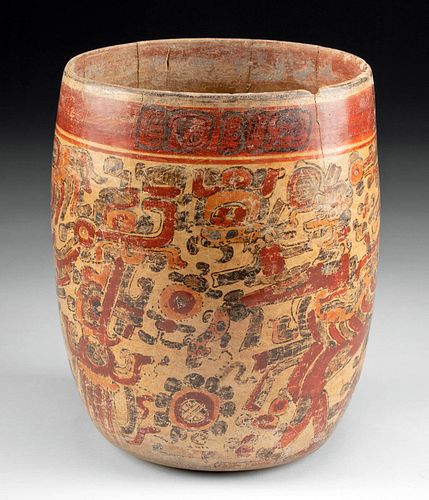Rare Maya Naranjo Polychrome Cylinder w/ Jaguar God
About Seller
686 S Taylor Ave, Ste 106
Louisville, CO 80027
United States
Selling antiquities, ancient and ethnographic art online since 1993, Artemis Gallery specializes in Classical Antiquities (Egyptian, Greek, Roman, Near Eastern), Asian, Pre-Columbian, African / Tribal / Oceanographic art. Our extensive inventory includes pottery, stone, metal, wood, glass and textil...Read more
Two ways to bid:
- Leave a max absentee bid and the platform will bid on your behalf up to your maximum bid during the live auction.
- Bid live during the auction and your bids will be submitted real-time to the auctioneer.
Bid Increments
| Price | Bid Increment |
|---|---|
| $0 | $25 |
| $300 | $50 |
| $1,000 | $100 |
| $2,000 | $250 |
| $5,000 | $500 |
| $10,000 | $1,000 |
| $20,000 | $2,500 |
| $50,000 | $5,000 |
| $100,000 | $10,000 |
| $200,000 | $20,000 |
About Auction
Nov 10, 2022
Museum-worthy examples of classical antiquities (Egyptian, Greek, Roman, Near Eastern), Viking, Far East / Asian, Pre-Columbian, African / Tribal, Oceanic, Native American, Spanish Colonial, Nautical, Fossils, Ancient Jewelry, Fine / Visual Arts, so much more! Artemis Gallery info@artemisgallery.com
- Lot Description
Pre-Columbian, Guatemala, Eastern Peten Lowlands, Maya, Naranjo Area Group, Early Classic Period, ca. 500 to 600 CE. A sizable pottery vase of tall cylindrical form with gently convex walls decorated in red, orange, black, and gray pigments. Illustrated on the body are 2 depictions of the Hero Twin Xbalanque (known as GIII) in his disguise as the Jaguar God of the Underworld (or the Old Jaguar Paddler). One figure stands in a striding pose and the other sits on a chthonic canoe, each with finely decorated jaguar claws, an abstract skull-form face, and an enormous wing evocative of the mythological Celestial Bird. A sizable third decoration appears to show another disembodied wing above perhaps an abstract anthropomorphic soul, and the tendril-form base beneath is perhaps depicting the "maw of Xibalba," or the gateway to Hell. Three groups of non-primary standard sequence glyphs are written in black around the rim. Size: 7.25" W x 8.6" H (18.4 cm x 21.8 cm)
According to Maya expert Dorie Reents-Budet, "Naranjo Area Group pottery is characterized by round-sided bowls and slightly convex-sided cylinder vases whose slip palette includes dark red, orange, black and gray on a yellow-orange or cream-white background. The vessels' lips are painted with a narrow black (or occasionally red) line. On the cylinder vases, a broad dark red band is painted around the interiors and exteriors just below the rim, and non-PSS [primary standard sequence] glyphs are painted in simple black line on top of the red exterior bands. PSS texts are found on bowl forms, painted directly on the yellow-orange background, their irregularly shaped glyphs also created by simple outline either in black or red. The Naranjo Area Group is distinguishable by its restricted iconographic programs that include a full figure rendering of GIII (Xbalanque) as the Jaguar God of the Underworld. He may be a manifestation of the Old Jaguar Paddler, who is one of the Paddler Twins who takes the soul of the deceased to the underworld in a canoe. Usually he is embellished with the personified wing of the Celestial Bird, whose pre-Columbian name may be Itzam-Yeh. Itzam-Yeh marks the zenith of the Maya axis mundi, or World Tree. The Wakah Chan, or Milky Way, is the celestial path along which traverses the canoe of death as it falls into the underworld (below the western horizon). This path's Mayan name is Xibal Be, or Road to the Underworld. The Jaguar God of the Underworld occasionally is depicted on Naranjo Area Group vessels with a human standing in his canoe; presumably this passenger is going to the underworld. The dance of apotheosis out of the underworld is found on other Naranjo Area Group vases." (Dorie Reents-Budet. "Painting the Maya Universe: Royal Ceramics of the Classic Period." Duke University Press, 1994, pp. 203-206)
Cf. Dorie Reents-Budet. "Painting the Maya Universe: Royal Ceramics of the Classic Period." Duke University Press, 1994, p. 205, fig. 5.46 and p. 276, fig. 6.48
Provenance: ex-Marc Amiguet Schmitt estate, Amiguet's Ancient Art, Evansville, Indiana, USA, acquired prior to January 1, 2010
All items legal to buy/sell under U.S. Statute covering cultural patrimony Code 2600, CHAPTER 14, and are guaranteed to be as described or your money back.
A Certificate of Authenticity will accompany all winning bids.
We ship worldwide and handle all shipping in-house for your convenience.
#173341Repair to one area of wall with stabilized fissures underneath, with small chips and light adhesive residue along break lines. Chips and stabilized fissures along rim and beneath base, with abrasions and minor fading to pigment on exterior surfaces, otherwise in excellent condition. Wonderful preservation to pigment in most areas with clear iconography, and nice root marks within basin.Condition
- Shipping Info
-
Artemis Gallery will no longer be able to offer in-house shipping for most international orders, as well as all oversized orders, including most paintings. These items are clearly marked in the listing as “3rd Party Shipping Required” in the listing. We have a list of recommended third party shippers to assist you in shipping to and from, and would be happy to assist you in working with them. We require a written authorization from the client to release property to any third party. You may fax a Shipping Release Form to 303-828-3235 or email your authorization to kristen@artemisgallery.com. Please note the all property must be removed from our premises within seven (7) business days following the last day of the auction.
-
- Buyer's Premium



 EUR
EUR CAD
CAD AUD
AUD GBP
GBP MXN
MXN HKD
HKD CNY
CNY MYR
MYR SEK
SEK SGD
SGD CHF
CHF THB
THB














